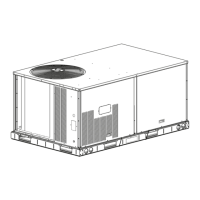39
Fig. 64 — Enthalpy Changeover Set Points
Indoor Air Quality (IAQ) Sensor Input
The IAQ input can be used for demand controlled ventilation
control based on the level of CO
2
measured in the space or
return air duct.
Mount the accessory IAQ sensor according to manufacturer
specifications. The IAQ sensor should be wired to the AQ and
AQ1 terminals of the controller. Adjust the DCV potentiome-
ters to correspond to the DCV voltage output of the indoor air
quality sensor at the user-determined set point. See Fig. 65.
If a separate field-supplied transformer is used to power the
IAQ sensor, the sensor must not be grounded or the
EconoMi$er
®
IV control board will be damaged.
When using demand controlled ventilation, the minimum
damper position represents the minimum ventilation position
for VOC (volatile organic compounds) ventilation require-
ments. The maximum demand ventilation position is used for
fully occupied ventilation.
When demand controlled ventilation is not being used, the
minimum position potentiometer should be used to set the oc-
cupied ventilation position. The maximum demand ventilation
position should be turned fully clockwise.
Fig. 65 — CO
2
Sensor Maximum Range Settings
Exhaust Set Point Adjustment
The exhaust set point will determine when the exhaust fan runs
based on damper position (if accessory power exhaust is in-
stalled). The set point is modified with the Exhaust Fan set point
(EXH SET) potentiometer. See Fig. 63. The set point represents
the damper position above which the exhaust fans will be turned
on. When there is a call for exhaust, the EconoMi$er IV controller
provides a 45 ± 15 second delay before exhaust fan activation to
allow the dampers to open. This delay allows the damper to reach
the appropriate position to avoid unnecessary fan overload.
Minimum Position Control
There is a minimum damper position potentiometer on the
EconoMi$er IV controller. See Fig. 63. The minimum damper po-
sition maintains the minimum airflow into the building during the
occupied period.
When using demand controlled ventilation, the minimum
damper position represents the minimum ventilation position
for Volatile Organic Compound (VOC) ventilation require-
ments. The maximum demand ventilation position is used for
fully occupied ventilation.
When demand controlled ventilation is not being used, the
minimum position potentiometer should be used to set the oc-
cupied ventilation position. The maximum demand ventilation
position should be turned fully clockwise.
Adjust the minimum position potentiometer to allow the mini-
mum amount of outdoor air, as required by local codes, to enter
the building. Make minimum position adjustments with at least
10°F temperature difference between the outdoor and return-
air temperatures.
To determine the minimum position setting, perform the fol-
lowing procedure:
1. Calculate the appropriate mixed air temperature using the
following formula:
T
O
= Outdoor-Air Temperature
OA = Percent of Outdoor Air
T
R
= Return-Air Temperature
RA = Percent of Return Air
T
M
= Mixed-Air Temperature
As an example, if local codes require 10% outdoor air
during occupied conditions, outdoor-air temperature is
60°F, and return-air temperature is 75°F.
(60 x 0.10) + (75 x 0.90) = 73.5°F
2. Disconnect the supply air sensor from terminals T and T1.
3. Ensure that the factory-installed jumper is in place across
terminals P and P1. If remote damper positioning is being
used, make sure that the terminals are wired according to
Fig. 57 and that the minimum position potentiometer is
turned fully clockwise.
4. Connect 24 vac across terminals TR and TR1.
5. Carefully adjust the minimum position potentiometer until
the measured mixed air temperature matches the calcu-
lated value.
6. Reconnect the supply air sensor to terminals T and T1.
Remote control of the EconoMi$er IV damper is desirable
when requiring additional temporary ventilation. If a field-
supplied remote potentiometer (Honeywell P/N: S963B1128)
is wired to the EconoMi$er IV controller, the minimum posi-
tion of the damper can be controlled from a remote location.
CONTROL
CURVE
A
B
C
D
CONTROL POINT
APPROX.
°F (°C)
AT 50% RH
73 (23)
70 (21)
67 (19)
63 (17)
1
2 1
4
1
6
1
8 20
2
2
2
4
26
28
3
0
32
3
4
3
6
38 4
0
42
4
4
4
6
9
0
1
0
0
80
70
60
50
4
0
30
2
0
10
E
NTHALPY BTU PER POUND DRY AIR
85
(29)
90
(32)
95
(35)
100
(38)
105
(41)
110
(43)
35
(2)
35
(2)
40
(4)
40
(4)
105
(41)
110
(43)
45
(7)
45
(7)
50
(10)
50
(10)
55
(13)
55
(13)
60
(16)
60
(16)
65
(18)
65
(18)
70
(21)
70
(21)
75
(24)
75
(24)
80
(27)
80
(27)
85
(29)
90
(32)
95
(35)
100
(38)
A
A
B
B
C
C
D
D
R
ELATIVE HU
MIDITY (
%)
HIGH LIMIT
CURVE
APPROXIMATE DRY BULB TEMPERATURE °F (°C)
0
1000
2000
3000
4000
5000
6000
2345678
Range Configuration (ppm)
Damper Voltage for Maximum Ventilation Rate
CO Sensor Max Range Setting
800 ppm
900 ppm
1000 ppm
1100 ppm
(T
O
OA
)
+(T
R
x
RA
)= T
M
100 100
x

